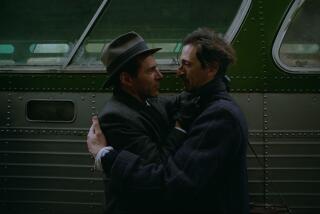Berlin’s big world
Berlin — Midway through “Untold Scandal,” an unabashedly sexy telling of “Dangerous Liaisons” set in 18th century Korea that I watched at the recent Berlin International Film Festival, the couple seated in front of me left the theater. They were young, which is perhaps why I had forgiven their distracted snuggling -- movies have always been places for discreet intimacy. But 20 minutes after they left, the young couple came back. They didn’t smell of smoke, so I don’t imagine they had gone out for a cigarette.
This warm reception may not be exactly typical of Berlin, but it’s a kick to think it reflects the passion the festival brings out in true believers. One of the premier festivals in the world alongside Cannes and Venice, Berlin has all sorts of reasons to recommend it, including a large market and various production initiatives that earned it the nickname of “junior Cannes” from one distributor.
But for movie lovers, what Berlin offers is nothing less than the world in the form of 400 films from some 80 countries, screening at a time when the weather is so grim, and the skies so gray, there’s little reason to leave the theater. Except, of course, as with my young couple, if you have been unexpectedly moved to do so.
Alas, their passion won’t help director E J-Yong secure U.S. distribution for “Untold Scandal,” even if his take on the Choderlos de Laclos tale is as enjoyable and sumptuously mounted as Stephen Frears’. Asia is where it’s at for many cinephiles these days, but French film remains a safer gamble in the United States than even most mainstream fare from Korea, China, Japan and new hot spot Thailand.
At a festival like Berlin, distributors look for sure things, programmers ferret out crowd-pleasers, and scores of journalists feed the home audience a stream of glitz -- or at least a wheezing trickle. (Witness Faye Dunaway hitting a front-page trifecta and landing on the cover of three newspapers.) For the rest of us, though, some of the most memorable nights light up without stars.
A global tour
At Berlin, I feel like a world traveler with an unrestricted visa. From one day to the next, I visit Niger with Rahmatou Keita’s “Al’leessi ... an African Actress,” about one of that country’s film pioneers, and China with Zhu Wen’s “South of the Clouds,” a moving story about a retired factory worker looking back on his life of disappointments. I hang out in Brazil with Roberto Moreira’s “Up Against Them All” -- Dad’s a hit man, Mom and daughter are nympho-freaks -- staying through the film only because I have nothing else to do. I visit both Hamburg and Istanbul in one of the best entries in the festival, Fatih Akin’s Golden Bear winner “Head On,” an exuberant, beautifully realized drama about Turkish-German lovers caught in the no-man’s land between their cultures -- a perfect film to premiere not far from the old Checkpoint Charlie.
One competition film that received a disproportionate share of early press attention, mostly because its director is a certified auteur and, I imagine, because no one had seen it, was the John Boorman. “Country of My Skull” tracks South Africa’s post-apartheid “truth and reconciliation” hearings through two reporters. It stars the unlikely couple of Samuel L. Jackson as a righteously angry Washington Post reporter unlike any I know (he flies first class, for one) and that reliable waterworks Juliette Binoche as a South African native with an inexplicable French accent. It’s a heartfelt but awkward misfire and I felt embarrassed for Boorman. The film was picked up for U.S. distribution by Sony Classics, which I didn’t know when I badmouthed it to one of the company’s executives.
Berlin has a reputation for hosting political films, which is a drum journalists beat incessantly. (Cannes has the glamour, while Venice now has the meddlesome Silvio Berlusconi.) There are political films here, but this in itself seems unremarkable because, as Indian director Partho Sen Gupta said after one of his screenings, “politics are part of life.” Gupta’s “Let the Wind Blow,” about disaffected young people in New Delhi, takes place during a game of nuclear chicken between India and Pakistan, and centers on a teenager whose future is closing in around him. Named after a prince in “The Mahabharata,” Arjun frequents brothels, boozes heavily and curses like a New Yorker, which caused an Indian woman in one audience to ask Gupta what language his characters speak. “I don’t recognize it,” she said, shocked.
Another audience member, an American, complained about the film’s bleak ending; he hadn’t recognized the kind of Indian film he had just seen. The popular view of Indian cinema -- gaudy Bollywood versus classic Satyajit Ray -- doesn’t allow for a work like “Let the Wind Blow,” which seems as much a product of its director’s French film school training as his New Delhi youth. Like a growing number of foreign-language features, “Let the Wind Blow” concerns characters at the mercy of a global economy that’s rapidly eroding their old ways of life. Freed from British rule, though not its post-colonial aftershocks, Gupta’s young men and women pursue money to the point of despair, nihilism. They get drunk while watching MTV and lament that, unlike those who fought for independence, they don’t have their own story.
The new pseudo-realism
Shot in digital video, “Let the Wind Blow” is an example of the new pseudo-realism that I find alternately invigorating and tiresome. So much cultural production now falls under the heading of nonfiction (as with the vogue for memoirs) and has the texture of real life -- or something like it.
In television, carefully choreographed “reality” shows are ubiquitous, while fiction filmmaking is filled with work that -- like that of Lars von Trier and his Dogma brethren -- resembles documentaries, or at least our cliched ideas about the genre. (With the rage for hand-held camera work, I find myself yearning for more beautiful, classically composed images.) The economics of digital video is a factor, of course, but there also seems to be some sort of search for truth at stake too, perhaps for an ontological truth -- but why now?
The search for truth also drives a number of films about time and memory, a trend that may speak to the speeded-up rhythms of our world -- it can be difficult to remember amid so much noise and confusion. In selections as dissimilar as Andrew Lau and Alan Mak’s fantastic “Infernal Affairs II,” Omar Naim’s dank, crypto-Philip K. Dick thriller “The Final Cut” and Richard Linklater’s “Before Sunset,” his lovely follow-up to “Before Sunrise,” the past hangs over the present as threat or promise.
Like Sundance, Berlin featured memory films that revisit a violent incident until a mosaic image of what happened comes into view. The strategy recalls “Rashomon,” but there’s an obsessive-compulsive aspect to how these new films disclose their secrets, as if the characters -- or the story itself -- were undergoing confession or perhaps psychoanalysis.
One familiar complaint about the Berlin film festival is that its selections are often gloomy, which sometimes seems like code for movies that are openly political and sometimes suggests that the work doesn’t look like Hollywood. There’s no question that when a filmmaker like Ken Loach pounds home a ham-fisted lesson in correctness -- as he does in “A Fond Kiss,” about a romance between a Catholic woman and a Muslim man living in Glasgow -- the gloom is as oppressive as L.A. smog. But there’s something exciting about a festival with so many films that take on the world in which we live, not just its dream, and acknowledge the past is never truly past. The endings may not be sweetened here, but I find in Berlin, it’s darkness that can paradoxically light up the screen.
More to Read
Only good movies
Get the Indie Focus newsletter, Mark Olsen's weekly guide to the world of cinema.
You may occasionally receive promotional content from the Los Angeles Times.










